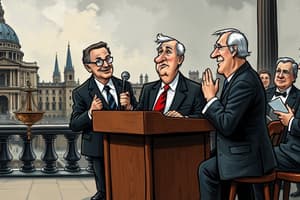Podcast
Questions and Answers
What is a cartoon?
What is a cartoon?
- A type of written literature
- A realistic drawing
- A scientific illustration
- A humorous drawn picture (correct)
Cartoons only reflect light-hearted fun.
Cartoons only reflect light-hearted fun.
False (B)
What does body language in cartoons provide?
What does body language in cartoons provide?
Non-verbal clues about mood and attitude.
What is a caricature?
What is a caricature?
What is the function of speech bubbles in cartoons?
What is the function of speech bubbles in cartoons?
A ______ is a sequence of drawings telling a humorous or adventurous story.
A ______ is a sequence of drawings telling a humorous or adventurous story.
What do movement lines indicate in cartoons?
What do movement lines indicate in cartoons?
What does irony in cartoons refer to?
What does irony in cartoons refer to?
Onomatopoeia words are usually found inside speech bubbles.
Onomatopoeia words are usually found inside speech bubbles.
Match the cartoon techniques with their descriptions:
Match the cartoon techniques with their descriptions:
Flashcards are hidden until you start studying
Study Notes
Cartoons
- Cartoons are humorous drawn pictures that can be light-hearted, reflect social trends, or highlight serious issues.
- When analyzing cartoons, consider elements like body language, caricature, intention, speech bubbles, thought bubbles, captions, comic strips, frames, movement, punctuation, stereotypes, verbal clues, visual metaphors, irony, parody, and satire.
Body Language
- Body language provides nonverbal cues about mood and attitude through elements such as body pose, gestures, facial expressions, and eye movements.
Caricature
- Caricature exaggerates features or actions of a person. For example, Barack Obama may be drawn with big ears, a long chin, and big teeth.
Intention
- Determine if the cartoon aims to amuse, make a political statement, or ridicule someone (satire).
Speech Bubbles and Thought Bubbles
- Speech bubbles indicate spoken words, while thought bubbles represent unspoken thoughts.
Comic Strips and Frames
- Comic strips are sequences of drawings telling a story, with each drawing being a frame.
Movement
- Movement is indicated by vertical, curved, and diagonal lines. Speedy action is shown through streaky lines or by the action going out of the frame.
Punctuation
- Punctuation is cleverly used to create meaning.
Stereotypes
- Stereotypes are exaggerated generalizations about a specific group of people.
Verbal Clues
- Parts of the drawing can help the reader understand the cartoon's meaning.
Visual Metaphor
- A visual metaphor compares two things, where a picture represents something else.
Irony
- Irony occurs when one thing is said, but something else is meant.
Parody
- Parody imitates a piece of writing to ridicule the original or make a satirical point.
Satire
- Satire uses humor to make a serious point, employing wit, irony, or sarcasm to highlight human vices or follies.
Analyzing Cartoon Techniques
- Five key elements to consider when analyzing cartoon techniques include: speech bubbles, thought bubbles, facial expressions, body language, movement lines, and onomatopoeia.
Facial Expressions as a Technique
- A lack of speech bubbles can convey a message or a character's attitude/reaction.
- Examples include: indicating shock/surprise, emphasizing anger, creating tension, and showing confusion.
Thought Bubbles as a Technique
- Thought bubbles can indicate:
- A character deeply in thought.
- Someone holding back thoughts.
- A character's thoughts being an exclamation or "secret" comment.
- The thought process behind spoken words.
Movement Lines as a Technique
- Movement lines show how characters move and highlight their movements and motives.
- Examples include: sharp movement lines depicting a powerful punch, frantic waving indicated by lots of movement lines.
Onomatopoeia as a Technique
- Onomatopoeia are words that mimic sounds.
- They can add humor and indicate action without spoken words.
Studying That Suits You
Use AI to generate personalized quizzes and flashcards to suit your learning preferences.




